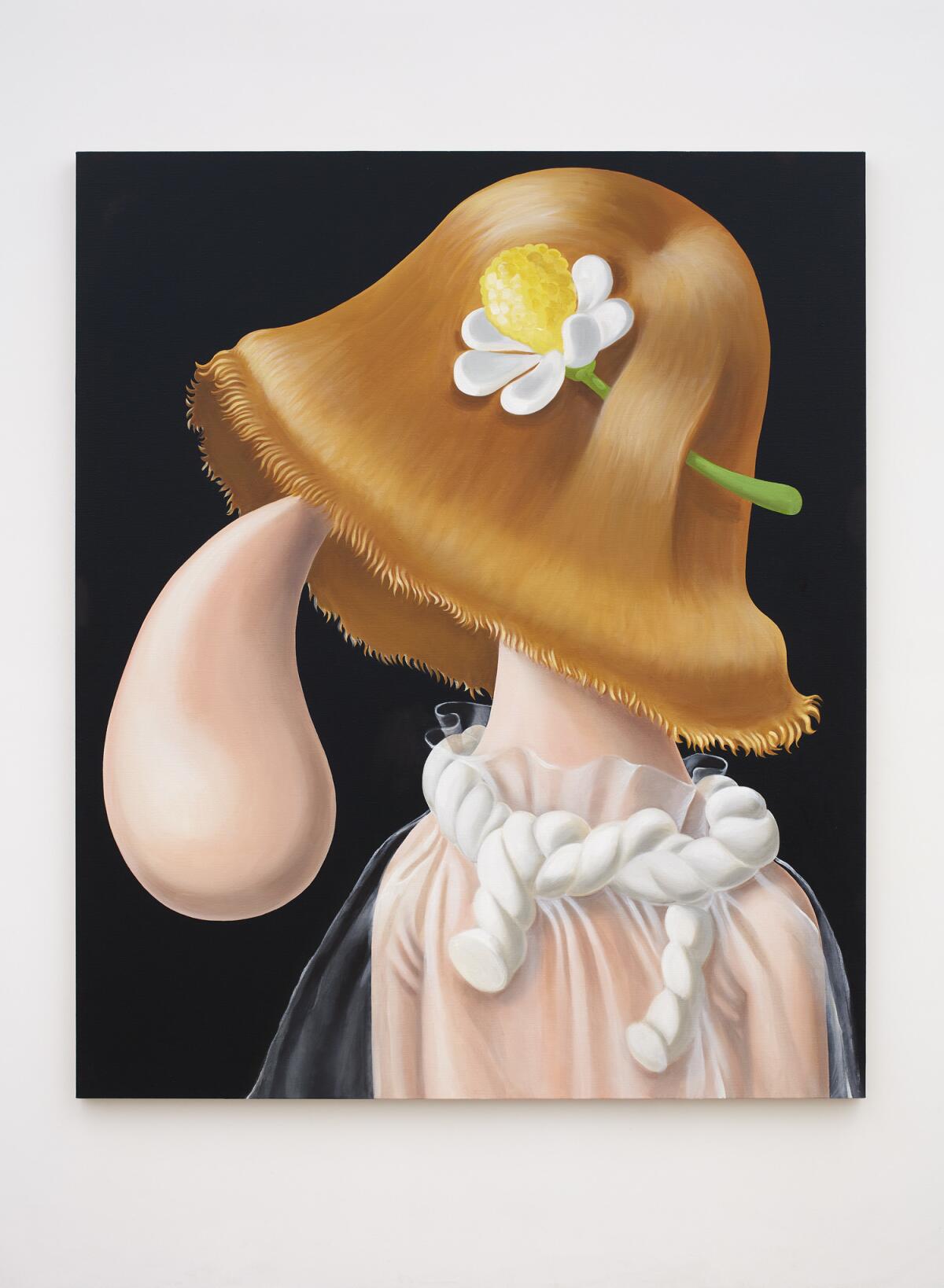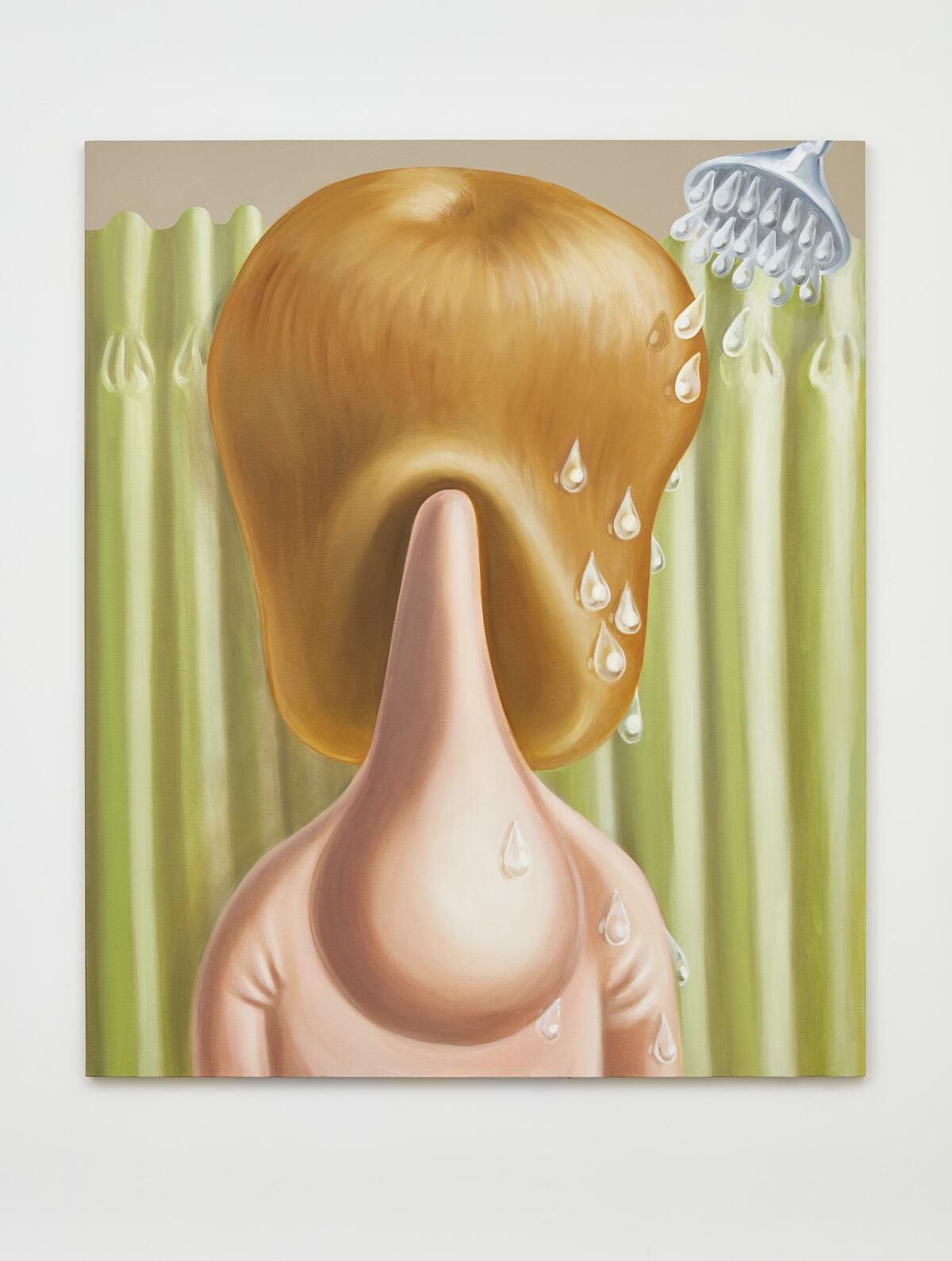Review: Full-frontal absurdity: The world of Louise Bonnet’s fleshy, surreal portraits
- Share via
Louise Bonnet uses the language of humor to talk about things that are sad. Her quiet paintings of oddly distorted figures are rendered in a cartoony style reminiscent of artists like Peter Saul or Kenny Scharf, but where theirs are riotous and boldly colored, Bonnet’s are placid and softly luminous. Her first solo exhibition at Mier gallery in Los Angeles feels like a fresh take on the now familiar intersection of painting and comic book style.

The L.A. artist’s closest touchstone may in fact be Philip Guston, whose late work employed a roughhewn graphic style to paint brilliant images of existential dread and loneliness. Bonnet’s work is more polished, harking back not to Abstract Expressionism but to the Old Masters. It’s a subtle reference that lends depth to Bonnet’s quiet dramas.
Her subjects engage in mild, humdrum activities: taking a shower, lounging at a picnic, tucking a flower into a pocket. With their absurdly long, bulbous noses and thick mops of hair, the subjects could have their activities played for slapstick, yet a quiet undercurrent of melancholy runs throughout.
“The Daisy,” for example, is a profile portrait of a woman set against a simple, jet-black background. The composition is classic, and the woman wears a translucent garment gathered around her neck that resembles, ever so slightly, an Elizabethan collar. Yet, in Bonnet’s rendering, the hair is not a cascade of comely curls, but a stolid helmet obscuring the entirety of her face — except, of course, for her long, drooping, teardrop nose. The garment is tied with a rope that would look more at home in Popeye’s hands, and the body glimpsed through the filmy fabric is oddly sexless, revealing neither breasts nor nipples. As much as Bonnet gives, she takes away, leaving us in a strange, slightly uncomfortable place.
The ambiguity derives chiefly from the tension between the figures’ ridiculously assertive noses and the refusal enacted by their helmet-hair. Deprived of access to their eyes (still the windows to the soul), we are left with their bulging, distorted proboscises. Freudian readings are unavoidable here, nowhere more so than in “The Red Pants,” where the tip of a man’s fleshy, dangling nose swings just above his crotch. Bonnet diffuses the salaciousness of this proposition, however, by featuring his hands gently cradling a small bouquet of yellow flowers.
The figure in “The Bubbly Water” is similarly melancholic: She looks like nothing less than a recovering alcoholic divorcee, drowning her sorrows in a glass of seltzer. But that interpretation is all conjecture. We can’t see anything but her hair and her bulbous nose, dipping into her glass.

These figures are all body, or rather, it seems their bodies have run away with them. The show’s best paintings approach the feeling of simply being in a body. Perhaps the strongest is “The Shower,” a full-frontal portrait of another blonde figure with an enormous, teardrop nose, pelted by drops from the stingiest showerhead ever. The foreshortening of the nose in this image is somewhat odd, rendering the extremity as a rather flat shape that appears to be floating or hanging in front of the figure’s hair. This surreal, disembodied effect heightens the impression of an abstract fleshiness, as if the nose has become a separate entity.
We are all intractable flesh to a certain extent, stuck in the bodies we’re given, subject to their whims and peculiarities. Although she worked in a totally different context, painter Maria Lassnig comes to mind here, as she so astutely probed the experience of what it means to inhabit a body. Bonnet does something similar with her cartoon-inspired style. Its distortions and stylization are more than a cool nod to pop culture or a simple grotesquerie; they highlight how awkward it is to be alive.
------------
Mier, 1107 Greenacre Ave., Los Angeles. Through Jun. 4. Closed Sundays and Mondays. (323) 498-5957, www.miergallery.com
Follow The Times' arts team @culturemonster.
The biggest entertainment stories
Get our big stories about Hollywood, film, television, music, arts, culture and more right in your inbox as soon as they publish.
You may occasionally receive promotional content from the Los Angeles Times.







